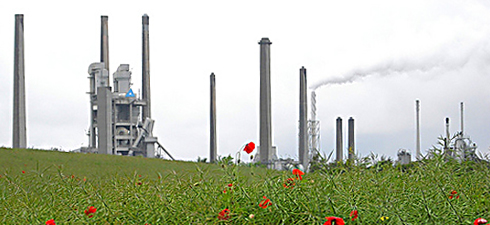From 2013 on, the industries with the biggest carbon footprints will have to buy their emission credits in a cap-and-trade financial market at a negotiable price upwards of €30 per tonne of carbon dioxide. So much for the theory. In practice, while it was initially proposed to gift free emission allowances to a couple of sectors that are particularly vulnerable to international competition in order to prevent “carbon leakage” to pollution havens, the list of exemptions now looks like a fairly comprehensive directory of industrial activity. In fact, the European Commission has exempted no fewer than 164 “sensitive” sectors and subsectors.
Naturally, steel, cement and aluminium top the list. But it also features manufacturers of undergarments, wallpaper, pharmaceuticals, essential oils, weapons – even brooms! All told, these industries account for about a quarter of total emissions under the EU Greenhouse Gas Emission Trading System, and up to 77% of total emissions from the manufacturing sector. Instead of having to purchase auctioned emission credits from 2013 on, these industries could be granted a “licence to pollute” free of charge. “This list was put together just in case no agreement is reached at Copenhagen,” explains Commission spokeswoman Barbara Helfferich.
A safety net if Copenhagen fails
In most of the capitals and, above all, in management circles, this list of derogations is basically taken for granted, whatever the upshot of the negotiations. We’ve come up with an excessive list! declaims British MEP Chris Davies. The competent policymakers are swell at defining ambitious goals, he adds, but things change when you get down to the nitty-gritty. According to the draft conclusions of this week’s European summit in Brussels, “This list will be revised depending on the outcome of the Copenhagen negotiations.” If an agreement is reached in Denmark, a real row is bound to break out afterwards, Davies prophesies. His German centre-right counterpart Karl-Heinz Florenz concedes that “If Copenhagen’s a big success, we won’t need the list any more. On the other hand, if it isn’t really a success, we’ll need it to protect our industry.”
This inventory of 164 sectors was put together swiftly to reassure industrialists and member state governments. Angela Merkel fought for her industry tooth and nail, beginning with lime and cement makers, and Silvio Berlusconi even bragged about having “got everything he wanted” to safeguard Italian manufacturers. All these industries then relentlessly lobbied Brussels for admission to the “sectors-at-risk” club. Faced with the looming threats of delocalisation, Europeans had to weigh up saving the climate against saving jobs. So now Europe will be lugging a life preserver along to Copenhagen in case the talks go belly-up.
CO2
Poland to hawk its emission credits
Poland’s climate policy has become a thorn in Brussels’ side, reports the Frankfurter Allgemeine Zeitung. Warsaw has just rejected Berlin’s proposal to let all CO2 emissions allowances that are not used by 2012 expire. On the contrary – and this would be a world first – Poland is planning to sell off some of its credits to Ireland and Spain for €40 million, which enable the latter to abide by their commitments to cut emissions, even while increasing them.
This is a “hard blow to the European Commission, which regards the emission allowances as a sort of birth defect of the Kyoto protocol”, notes the German daily. Poland had committed to a 6% reduction in CO2 emissions from 1988 levels by 2012. “To date, owing to the post-1990 decline of its heavy industry, Poland has reduced not by 6%, but by 29%.” According to the FAZ, “Poland is setting a precedent”: other Eastern European countries, including Russia and the Ukraine, have unused emissions credits, which the Commission estimates at 10 billion tonnes.
Was this article useful? If so we are delighted!
It is freely available because we believe that the right to free and independent information is essential for democracy. But this right is not guaranteed forever, and independence comes at a cost. We need your support in order to continue publishing independent, multilingual news for all Europeans.
Discover our subscription offers and their exclusive benefits and become a member of our community now!












